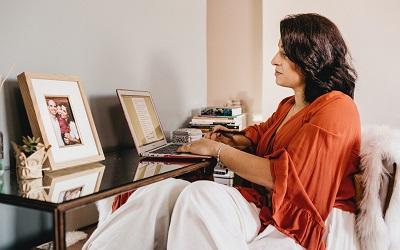You are here
- Home
- Business and Law in the time of COVID-19
- Working from home: can it impact on menopause?
Working from home: can it impact on menopause?

This blog is written by Joanna Brewis, Professor of People and Organisations in The Open University's Business School. Joanna is the Co-author of the Government Office Report Menopause transition: effects on women’s economic participation. This blog was originally published on 19 June 2020 and was written for the Henpicked website.
The coronavirus pandemic led to an unprecedented time globally. As many businesses were forced to temporarily close their doors, those that could work from home were told to do so.
A new way of working for many people. With the home a new workplace for a large number of women, what does the current ‘menopause in the workplace‘ look like?
Big changes to working life
There are a number of things to take into consideration. For starters, it’s not really as simple as a female employee upping sticks and working at home instead of the office. Other factors are at play. School closures mean those who are parents have been juggling a working day with a day of home schooling.
Parenting has suddenly become more intense, as women are balancing the needs of their children with their own. Partners are likely also working from home. And of course, some are furloughed, leading to those still working frantically trying to establish routines and find peaceful workspace. The worry of employment, the economy, the future… stress levels have been at an all-time-high. Which in itself is not good for menopausal symptoms.
We know that the ‘traditional’ workplace can sometimes exacerbate menopause symptoms, as the environment is out of a woman’s control. For women suffering from hot flushes, certain types of uniform can be unpleasant. Equally, lack of temperature control, ventilation or access to cold water can all make these worse. Working from home, in this instance, could help with these type of symptoms. Not having to wear a uniform, being able to control the heating and ventilation, having constant access to water.
Some women experience heavy or unpredictable periods during perimenopause, and while at work this can sometimes be stressful, especially if they can’t easily get to a toilet. Again, being at home could help here, with ready access and not having to explain constantly they’ll be away from their desk.
Sleep issues can be a big factor for many women, too, with night sweats causing disturbed sleep patterns. In turn, then having to arrive promptly at work for a certain time mean many are struggling with fatigue. The often more-flexible approach to remote working means women can arrange their working day to suit them.
A unique approach
While more workplaces are taking a positive and proactive approach to menopause support, it’s inevitable that often this is within certain restrictions. The nature of the job, the expectations of the role, the physical office environment.
Working at home means a woman can tailor their working day to their own very precise symptoms. If they need to open a window they can, without imposing on a co-worker. If they struggle with a sleepless night, they can flex their working day.
I mentioned earlier, there are a number of factors to take into account here. Women working at home can often find it difficult to keep a working day and a personal life separate, and they may find themselves boomeranging between demands of work, home and family.
Then there’s the technology to navigate. The Zoom call where no one can hear you. The kids walking in while you’re on a call. Installing new systems. Working out how to share documents. There’s no IT department at home, and many people are having to get to grips with things at pace.
For those living alone, there can be a real sense of isolation working from home. A Zoom call isn’t the same as a chat with colleagues face to face. Those seeking support from line managers might find access more limited, and workplace services such as counselling could have been paused or reduced.
The experience of menopausal women working from home
“We’ve talked to 100s of women through our training sessions during lockdown,” says Deborah Garlick of Henpicked: Menopause in the Workplace. “While some symptoms are easier to manage, women tell us other symptoms are increasing. Anxiety around COVID-19, moving to a new way of working, wondering if they’re doing a good job while detached from their work colleagues and line manager, even worrying if they will still have a job at the end of all this. Others who are living alone and feeling the effects of less social interactions and support generally whether they’re working from home or furloughed. It’s a lot on top of menopausal symptoms. Responsible employers are taking action and increasing their workplace wellbeing activity.”
So out of office does not mean menopause should be out of mind. We need to keep the conversations going and put the right support in place – whether the workplace is on the organisation’s premises or in the employee’s home.
